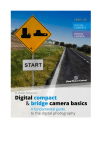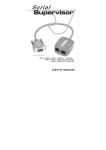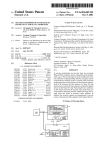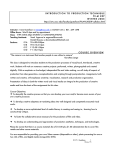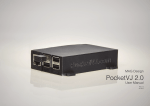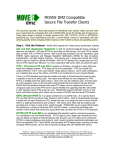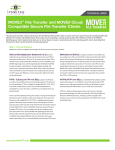Download PDF - Total Picture Control
Transcript
Contents of this e-book Why to read this e-book? Who is this book intended for? How to learn to take pictures? The advantages of this e-book About the Author Acknowledgements Online appendix to this e-book Disclaimer Copyrights Symbols used in this e-book and their meaning Introduction - What troubles a beginning photographer Chapter 1 - The basic questions of an educated photographer Chapter 2 - What lens should I use to take photographs? Practical excercise no. 1 - Properties of a lens Chapter 3 - Where should I stand? Coffee break Chapter 4 - Where should I focus? Practical excercise no. 2 - Selecting the focus points Chapter 5 - Practical step-by-step exercises Practical excercise no. 3 - Photographing subjects indoors Practical excercise no. 4 - Photographing subjects outdoors BONUS Appendix 1 - Climb to the top of your photographic knowledge Appendix 2 - Glossary of terms What is Total Picture Control? Who is this book intended for? This book is intended for all the enthusiastic owners of digital cameras, regardless of their age and level of education. It could be your first book about photography. My intention as the author - and a teacher of photography - is to encourage your interest in photography. The ability to take pictures is a creative skill of a cultural educated person. Why to read this e-book? In today's modern world of digital technology it is usual that you take into your hands a mobile phone, a smartphone, a tablet, a digital compact, bridge or a DSLR camera and you try to make a good photo. You rely on the amazing abilities of the intelligent electronics. You have been convinced that "it makes photos itself!" Despite the great advertising, the created photos do not meet your expectations. You are disappointed. You look for a way to make things right. You ask your friends, search on the internet, buy books. Today's books about photography are full of amazing pictures, quick guides and guaranteed tricks to make perfect photos. Some authors offer a quick response: "Hey Scott, how should I take a picture of this flower?" "Just look in the right way and do this with your camera..." They don't deal with explaining the basic concepts, they go straight to the point. These authors have (unfortunately) already forgotten how they learned to make photos. They have forgotten how they obtained their particular abilities. They describe taking pictures as something natural. They say that "it is enough to have eyes", after all it's that simple. You are impressed by their instructions. You try their tricks but the magic disappears. Once again you remain alone with these unanswered questions: How should I get rid of the automatic mode? What should I set up so that the photos meet my expectations? In this e-book we will answer the questions that keep troubling a beginning photographer like you. How to learn to take pictures? Photography, like other skills of people, consists of sequential abilities, steps. These lead a person to his/her overall ability to create or control something. How do you acquire these skills? Just remember, for example, how you learned to ride a bike in childhood. At first you didn’t know where to put your feet, what to do with your hands, how to strike the pedals and maintain your balance and direction at the same time. You were falling, it was difficult for you. However, little by little you involved different activities of this skill into a whole. And suddenly, hop! You gained control of riding and started enjoying the speed and graceful movements. From that moment on you will never forget how to ride a bike. Over some time, it is you who gives advice about cycling to a beginner and you wonder: „What does that clumsy one do with his/her legs? Why does he/she often lean on one side and loses his/her balance? I mean, riding a bike is so easy!” Now think of the tricks and tips of the authors of the books on photography that I have mentioned. Do you want to be able to take pictures? Just look in the right way and press the release, I mean, it's so easy! These authors have already forgotten how many little steps they had to do before they learned to take pictures. Today, it is nothing more for them than one complex skill which they control. And they wonder how come that the others do not understand it. Do you understand now how learning works? As a teacher of photography I can see the difficulties in making the first steps on a daily basis. Knowing how to gradually join these steps into a whole is difficult until the right moment comes and you'll suddenly know how to make a good photograph. In this book I will give you tips on how easy it is to learn to take pictures in a step-by-step way. I will acquaint you with my method of teaching. It is simple, perhaps it will surprise you. It is based on remembering a few questions, on being able to ask them yourself always at the right moment and on being able to answer them correctly according to the situation. I am offering you a step-by-step teaching method through which I have been successfully teaching the beginning photographers for five years. I have named this method the Total Picture Control. Find out how to get the content of your photographs under control. The advantages of this e-book - It makes use of all the possibilities of e-books and e-readers. - The text includes interactive links to the sources of information or to other locations within this e-book. - The interpretation of the professional issues is given in a form of simple questions and answers. - It includes practical illustrated instructions. - The examples and exercises are presented in a „step-by-step way“. Thus you can easily understand all the essential photographic techniques and procedures. - It includes an online appendix with photographs in high resolution. - It includes an online glossary of technical terms. - This e-book is a part of a comprehensive edition of textbooks for all levels of photographic skills - The method of interpretation and the difficulty of the explained issues are adapted to the level: - For photography beginners About the Author B. BoNo Novosad (1964), A photographer, photography teacher and entrepreneur. He has been dealing with photography and photographic techniques since 1980. In 1988 he graduated from the Technical University with an engineering degree. Since that time he has worked as a freelance photographer. In 2008 he founded his School of Digital Photography where he works as a chief lecturer and a teacher of photography. In 2010 he created a method of teaching photography and a series of textbooks on photography both entitled the „Total Picture Control”. Using this method he gives photographic classes and lectures and writes textbooks on photography. He works in Prague and Bratislava. Acknowledgements I thank my students for the questions asked during the courses and lectures. They help me to better understand the problems of the beginning photographers which contributed to the creation of the "Total Picture Control" method of teaching photography, as well as to the creation of this e-book. B. BoNo Novosad Online appendix to this e-book I hold to the principle that the essential ability of a photographer is to express things through images. All the photos in this book are very important for understanding the studied issues. The possibilities of some e-readers when displaying photos may be limited. Therefore, all the photos contained in this e-book can also be found in a special online appendix. If your e-reader has a web browser, to visit the online appendix click here. The online appendix can also easily be visited by entering this simple URL address in the web browser of your computer: http://www.to-pi-co.com/fugu-ca-en What will you find in the online appendix? - all the photos in high resolution - photos with the true colour rendition - photos logically grouped into photo galleries - photos used in the illustrative examples and exercises are arranged in the step-by-step way Other things you will find in the online appendix: - bonus photos which are not published in this e-book - photos showing the backstage preparation of examples and exercises - unique "behind the scenes" photos on which you can see and learn "how the things were photographed" A short online glossary of technical terms As a bonus I am offering you a short, online glossary of the technical terms, that I use in the explanatory part of each of my textbooks. The important terms and expressions in the text of this book are highlighted as interactive links to the online glossary. If you find a term or an expression in the text that is new to you, try to look it up in the online glossary on the website www.total-picture-control.com If your e-reader has a web browser, to visit the online glossary click here. The online dictionary can be visited by entering this simple URL address in the browser of your computer: http://www.to-pi-co.com/glossary The entries in the online dictionary have been carefully chosen and complemented by the appropriate photographs and illustrations in cooperation with our fellow graphic-designers and programmers. The entries are arranged according to the topic and level of knowledge. Do not hesitate to visit our website and get absorbed in reading its content. Here you will surely find what you've been searching for. Disclaimer With respect to the situations that involve some degree of uncertainty or risk, read carefully the following warnings before purchasing this e-book: The techniques and the practical exercises described in this e-book are intended for the readers with the following level of knowledge: Beginner - with knowledge about the basic use of a camera and its functions to the extent described in the basic user manual supplied by the camera manufacturer. Make sure that the level of your knowledge really meets the requirements stated above and that you can set and control the required functions on your camera. In order to master the techniques successfully and to achieve the proper results of the practical exercises described in this e-book it is necessary that your camera allows you to adjust the settings of at least the following basic photographic parameters: - Sensitivity of the image sensor (ISO) - Value of the shutter speed (S, Tv) - Value of the F-number (A, Av) - White balance (WB) Make sure in advance that the enumerated parameters are really available on the camera you want to use while studying these photographic techniques and working on the practical exercises and that the camera allows you to control them. The procedures described in this e-book are definitely not a substitute for the basic user procedures indicated in the basic user manual supplied by the camera manufacturer. Before you start following the procedures and practising the exercises presented in this e-book, study carefully the basic user manual of your camera. Before purchasing this e-book, make sure that your camera belongs to the class for which this e-book is intended. Furthermore, familiarize yourself closely with the disclaimer statement of the authors and the publisher. If your camera does not meet the above mentioned basic requirements, your user experience does not correspond to the level of knowledge mentioned above, you disagree with a provision in the disclaimer statement of the author and the publisher - do not buy this e-book! Your request to refund the purchase price which will be based on inconsistencies with the above will not be accepted by the vendor or the publisher. Disclaimer of the authors and the publisher The authors and the publisher devoted their maximum possible attention to the fact that the information indicated here corresponds to the current state of knowledge at the time of the preparation of the work for publishing. Although this information was carefully inspected, it is not possible to guarantee with absolute certainty its complete perfection, accuracy and topicality, absence of errors in the description of procedures or errors in the text. For these reasons, the publisher shall not be liable for any damage or other harm, excludes any claims for payment of damages, whether direct, indirect, special, incidental or consequential, that may result to the user from the use of such information. The content of this e-book is meant for information only. It may change without notification and can not be interpreted as a commitment of the publisher - the ecomVia a.s. company. Copyrights of third parties The author's intent was to use no copyrighted material for this e-book or, if this was not possible, to give information about the copyright related to the object in question. If you discover any unidentified object protected by copyright, it means the author was unable to determine this copyright. Contact the publisher at: [email protected] In the case of such an unintentional copyright infringement the author will remove the object from the publication or, after a notification of this fact, he will at least indicate the details about the relevant copyright. All trademarks, geographical names or other designations of third parties, or of the products or services of third parties which are mentioned in this e-book, belong to their rightful holders and are used solely to identify the persons concerned or their products or services. They are used only for demonstration purposes and are not intended as a reference or as a binding recommendation of any actual organization or as a recommended use of a product. Copyrights © 2013 ecomVia a.s. All rights reserved Translation: B. BoNo Novosad © 2013 Author of the e-book: B. Bono Novosad © 2008 Cover page photo: B. Bono Novosad © 2011 e-book cover page design: Peter Balík © 2012 e-book interior design: Martin Novosad © 2012 Web design & web production: Martin Novosad © 2011 ePub version: ISBN 978-80-89610-26-6 MOBI version: ISBN 978-80-89610-25-9 Without a prior written consent of the publisher - ecomVia a.s., publishing or redistribution of any part of the text or an image file from this publication or any part of the Website made available is a violation of the copyright law. This e-book, as well as the techniques described herein, are offered under a license and may be used, rented or copied only under the conditions and within the scope of this license. No part of this e-book shall be reproduced, stored in a retrieval system and transmitted in any form or by any means electronic, mechanical, recording or other, without the prior written consent of the copyright executor - the publisher - ecomVia a.s., except as permitted in the license. Please note that the photographs, schemes, pieces of art or paintings contained in this e-book that you might want to use in your projects, may be protected by copyright. Unauthorized inclusion of any part of such material into your new work could be a violation of the rights of the copyright owner. Please obtain a written authorization for the use of the work from the copyright owner! Currently granted license allows the purchaser to: Use this e-book only for the purpose of personal education. All rights reserved! © 2013 ecomVia a.s. Symbols used in this e-book and their meaning In each of my interpretation, in each of my e-books I prefer the graphic and visual way of expressing to the complex and extensive text. In your first e-book about photography I have also chosen the way of expressing through simple and easy-to-remember symbols. Basic information Motto Warning Tip Advice Control question Weblink Information about the distance Stand close (within a small distance) Stand at a normal distance (maintain a common distance) Stand at a long distance Basic questions of a photographer: What lens should I use? Where should I stand? Where should I focus? What shutter speed should I use? What F-number should I use? What white balance should I set? Properties of a lens Wide-angle lens Normal lens Telephoto lens Changing the parameters, setting the functions Basic dial Changing the value of a parameter Selecting from the menu of the device CHAPTER 1 The basic questions of an educated photographer Do you also have some of the troubles that I mentioned in the previous section? Are you looking for a solution to these problems? Are you looking for simple answers to the question "what am I doing wrong?" In each of my textbooks my aim is to teach you the photographic techniques in a simple way. I have created a teaching method called Total Picture Control, which is based on a few very simple questions. What do these questions and in particular the right answers to them mean to an educated photographer? I will briefly explain you their importance: What lens should I use? By selecting the properties of the lens a photographer decides what from the photographed scene will be captured in the photograph and how the perspective of the space that he/she can see in front of himself/herself will be captured. Where should I stand? The choice of the place from which the photographer takes the photograph, together with the properties of the lens will determine the size of the objects as well as the mutual proportions between the foreground and the background of the picture. Where should I focus? By focusing a point in the image area a photographer guides the eyes of the viewer of a photograph and, as a rule, he/she determines what will be its central theme. What shutter speed should I use? By choosing the shutter speed (the length of the exposure time) a photographer decides how the objects in motion will be captured in the photo. What F-number should I use? By setting the F-number (the aperture value) a photographer creates the sharp and blurred places in the photograph. What white balance should I set? By setting the properties of light of the photographed scene (the so called white balance) a photographer decides how truly will the colours of the photographed scene be captured in the photograph. The first three questions are dealt with in this e-book in separate chapters and practical exercises. I will teach you the meaning of each question. I will explain to you what you will reach by answering each question correctly and you will also see the results in the example photos. In the practical exercises I will teach you to answer the questions correctly and to apply them properly in practice. Each chapter and a practical exercise will take no more than a half an hour of your time. With each question and practical exercise you will acquire new knowledge and skills. When you combine these skills into a whole you will be able to make a technically correct photo. The last three questions are dealt with in separate textbooks: What shutter speed should I use? Understanding Tv mode on Canon DSLR - Take control of shutter speed A photography e-book dedicated to correct setting of exposure time on your Canon DSLR that will guide you step by step through all aspects of exposure time in the digital photography. What F-number should I use? Understanding Av mode on Canon DSLR - Take control of the aperture A photography e-book dedicated to correct setting of the aperture on your Canon DSLR that will make you understand all aspects of the aperture in the digital photography step by step. What white balance should I set? Understanding white balance with Canon DSLR - Take control of true colors A photography e-book dedicated to correct setting of white balance on your Canon DSLR that will explain how to achieve true colours of your shots under any circumstance step by step. Summary of knowledge REMEMBER THIS! Do you want to start taking pictures properly? Do you want your pictures to have success with viewers? I'll give you some important advice: Taking photographs is not merely looking for correct answers to the question "what should I set?". The ability to take photographs is a creative skill of a cultural educated person. If you want to start taking pictures properly, stop doing it like a tourist does: A tourist photographs "the way he/she can see". If you want to create eye-catching photographs that will have success with viewers - become a photographer - start to take photographs! A photographer creates the image. Remember: A photographer takes photographs of ordinary things in an extraordinary way. What is Total Picture Control? As a teacher of photography I am constantly faced with the fact that a beginning photographer understands photographing as a question of setting the camera correctly. He/she dedicates all the time and energy to studying of instructions for use, checking the discussion forums on the internet and reading books about photography whose authors have (unfortunately) already forgotten how they learned their individual skills and who describe photographing as something natural, claiming that it is enough to have eyes. It is very difficult to learn how to take pictures in the right way and to understand this comprehensive ability of a person at once. That's why I have divided the teaching of these comprehensive skills into several simple steps. I have formulated the right procedure to do these steps into 6 simple questions. I have named this method of teaching the Total picture control. Using this method I have been teaching photographic classes and giving specialized lectures, in which thousands of beginning photographers, irrespective of their gender and age, have taken part. Now I am offering you the most comprehensive edition of textbooks on photography created by this method: Total Picture Control is a complete edition of textbooks about photographing Under the title Total Picture ControlI am offering you a complete edition of textbooks about photography. Such an edition cannot be found in the offer of any other publisher. What makes it so unique? 1. The textbooks are classified into levels according to their degree of knowledge – from beginner to master level 2. The individual titles are interlinked within the same level of knowledge according to the discussed topics. 3. The titles are also interlinked in the growing level depending on the extent of knowledge 4. The titles are offered individually or grouped into sets – in this way you can get a complete set of knowledge and, of course, for a bargain price! Educate yourself! Reach to the top of the photographic knowledge - The Total Picture Control is your right way to the top! Stay tuned to he current news and bargains on Facebook! Like us on Facebook! Share your feedback on this e-book with us! Your opinions and comments make our books better. If you have suggestions for improvement or you found a bug, please let us know at this location.























